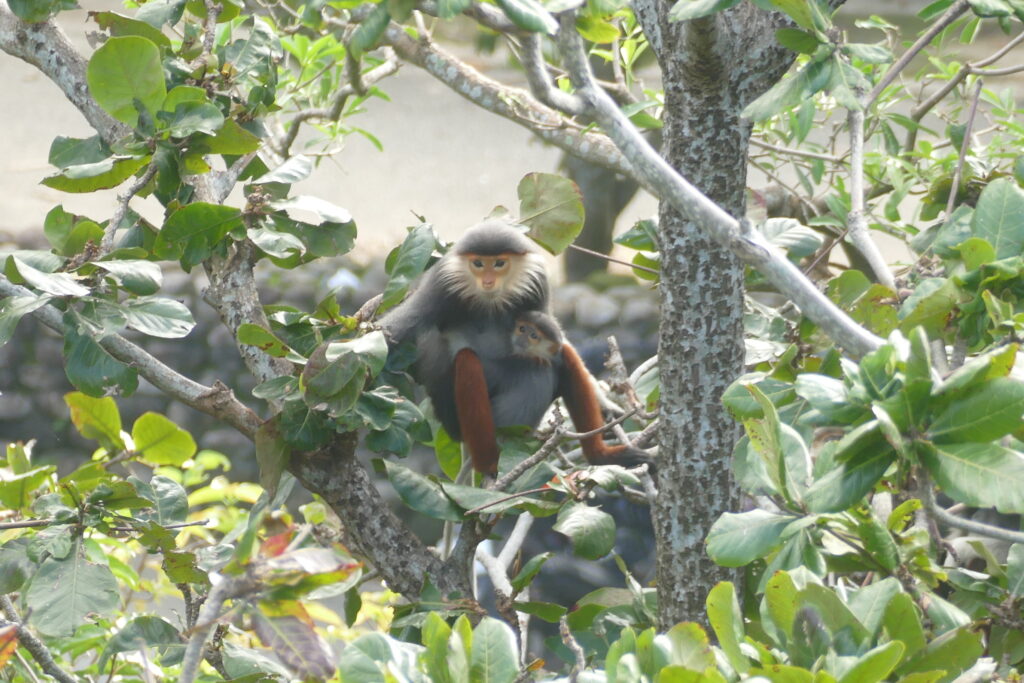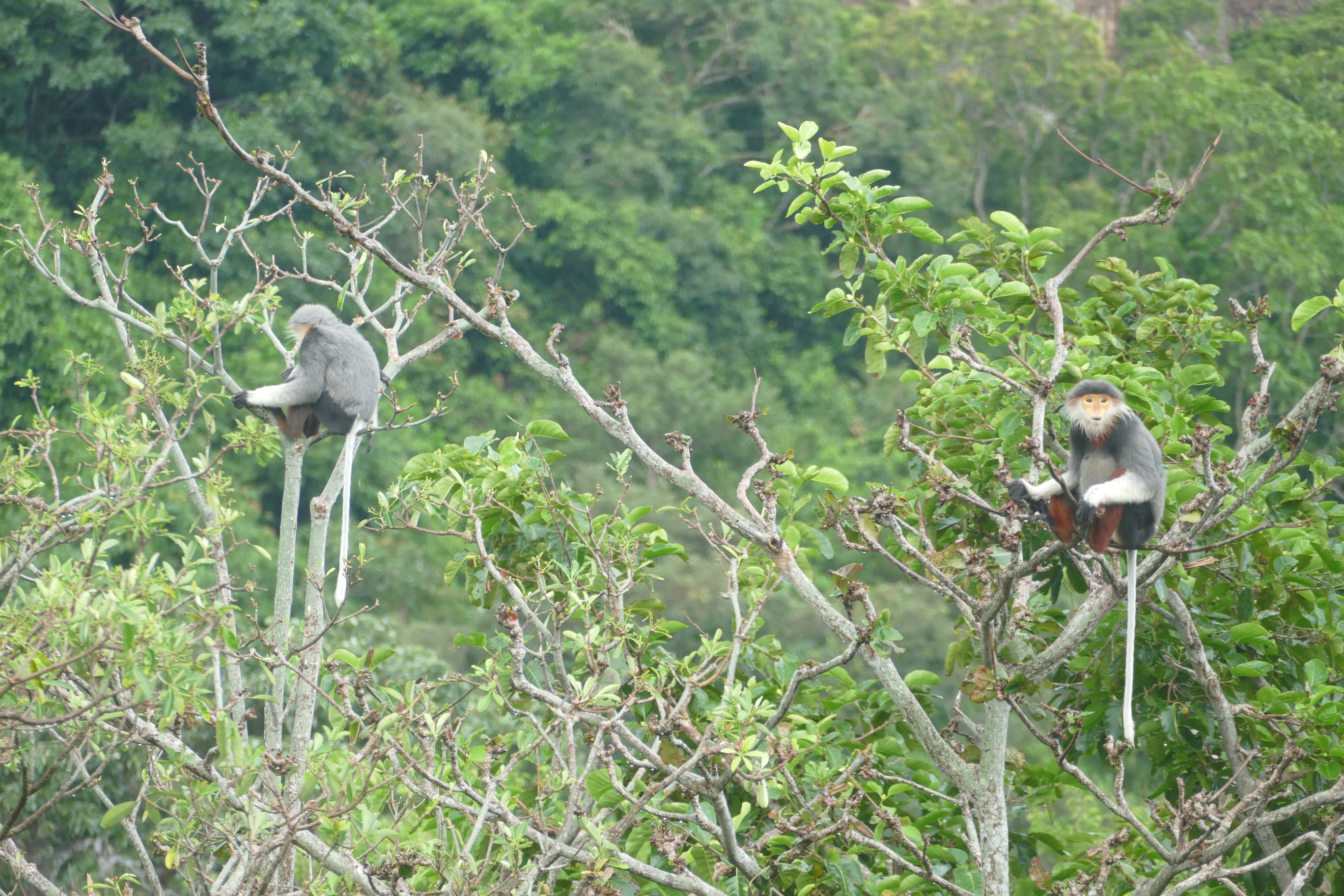“Joining hands with the community to protect intact forests and wild animals for future generations, that is my goal,” tells us Dr. Ha Thang Long, Vietnamese conservationist, leading Vietnamese primatologist and founder of GreenViet, an organisation that has largely strengthened the populations of various primate species in Central Vietnam and the Central Highlands. We meet Dr. Long in the bustling coastal city of Da Nang, to visit the Nature Education Centre of GreenViet and experience one of their biggest achievements: a thriving population of red-shanked douc langurs living in the last protected forest right next to the city.
The fights GreenViet took up are not small, to say the least. But at the same time, the team is responsible for one of the most successful wildlife conservation stories we’ve heard – the campaign of saving the forests and wildlife of the Son Tra peninsula from uncontrolled tourism development.
…and then, everything fell into place, and we founded an NGO in my hometown
Dr. Ha Thang Long has been working in the field of nature conservation since 1999, when he joined the efforts of the Frankfurt Zoological Society at the Endangered Primate Rescue Center in Cuc Phuong National Park. “I was thinking back then, why did foreigners come and seem so invested in protecting nature, and us Vietnamese who live here don’t do anything. I realised that what you need is passion, and my passion developed into becoming a primatologist.”
“With the other founders, we were dreaming of setting up a center that can bring enthusiastic people together, who are passionate about learning about and researching biodiversity and want to share its importance with the Vietnamese community. Back then I remember looking up at the Son Tra peninsula above Da Nang, a place where I spent a lot of time as a child, and wondering if there could possibly be langurs there. There was no proof back then, and the place is very isolated,” Dr. Long recalls. “After the war there was a fuel crisis, and much of the forest of Son Tra was cut down by locals. There was some record of red-shanked douc here before the war, but many were also poached for food during or after the war.”
So, Long started talking with people about it, and engaged students from Da Nang. “Back then, there were no roads on the peninsula, only to the radar stations operated by the military, so we did our observations from the boat,” he explains. And eventually, the red-shanked douc langurs were spotted. “When the first population of douc was found in 2008, everything fell into place, and in 2012 we founded the NGO GreenViet.”
Together to save the Son Tra peninsula
The red-shanked douc is called the queen of the primates. It has a golden face, white chin, dark grey to black hands and feet, but it got its name from its bright red “stockings” which run from its knees to its ankles. When it was rediscovered in Son Tra 15 years ago, the population was estimated to be about 300 individuals. Within its area of 4,500 hectares literally growing out of Da Nang, the old forests of Son Tra Nature Reserve are home to over 1,000 flora species and 120 fauna species, but due to extensive poaching, populations were decimated. Son Tra proved to remain a good habitat for wildlife because of the army’s presence, which is a common pattern. “Where there is an army base, movement is restricted and that creates a good place for wildlife,” Long agrees.
A group of red-shanked douc langurs of the Son Tra peninsula.
At the same time, the government and rich businessmen realised the tourism potential of this natural haven, and exploitation started. Although Son Tra is a Nature Reserve, the construction of holiday resorts has gradually been approved. Long tells us that in the last decade, new roads have been built, and holiday bungalows on scenic beaches destroyed a beach that was important for turtle nesting, while coral reefs have been damaged. “These roads are good for us who want to enjoy the nature of Son Tra, and spot its animals, but we should remember that of course, they are detrimental for wildlife,” Long puts things into perspective.
The team of GreenViet couldn’t watch this habitat destruction continue. They started a campaign to raise awareness about the red-shanked langurs, as many locals had no idea about their existence. They talked to small businesses, and explained to them that these large resorts would also draw revenue away from them, and convinced them that nature-based tourism in Son Tra can be a good way forward. That’s how more and more locals, influencers and small businesses joined the fight. “See Son Tra before it’s gone” was the motto with which locals and tourists were engaged to see the beauty and biodiversity of Son Tra. At the same time, over 13.000 people signed the petition started by GreenViet, and eventually, the expansion of the resort was stopped.
This was an incredible achievement for GreenViet and the locals. As the community’s awareness of wildlife protection increased, poaching numbers have also dropped, and Long tells us that the demand for wildlife meat has overall decreased in Da Nang. Thanks to GreenViet’s effort, the number of red-shanked docs has increased from 300 to over 2000 in 15 years, which is truly remarkable.
Nevertheless, the struggle is not completely over. Da Nang is a popular holiday destination and a scenic location for beach vacations, with surfing, snorkelling, beach promenades and tall holiday apartment buildings framing the coast. The Son Tra peninsula is the last healthy natural area left in the city, which also means GreenViet is fighting further expansion of these holiday resorts, with an additional 5000 beds planned and another 240 ha of land carved out of the territory of the nature reserve. But, local people and businesses keep raising their voices by saying “If this construction continues, you are going to kill us.”


Within its area of 4,500 hectares literally growing out of Da Nang, the old forests of Son Tra Nature Reserve are home to over 1,000 flora species and 120 fauna species.
A place for learning and knowledge sharing
Even to this day, there is little awareness about how easy it is to spot red-shanked douc in Son Tra. We took an early morning tour to search for them, knowing how difficult it is to spot primates in the wild, which move so fast and with such agility up in the tree canopy. But little did we know that these douc are quite comfortable with human presence. Just after we started our walk, we saw a group moving above us, and not long after, we found a perfect spot to observe a large group as they munched on the leaves of the treetops. An unforgettable experience for us, and we kept watching them as a raincloud passed by, and together – us as well as the douc – all got wet, after which we all celebrated the first rays of sunshine returning.
GreenViet wanted to create a place where people who are passionate about wildlife can come together, and finally in 2018, with the voluntary contributions of over 100 individuals, organisations and communities, the Nature Education Center was opened. “During summertime, many children come to our center. It can be up to 5000 students per summer, and tourists are also becoming interested,” tells us Long. “Overall, tourists are not yet coming in big numbers specifically to see the douc, but we hope that this will change in the future,” adds Long. GreenViet also works together with local hotels and restaurants to promote Son Tra’s natural values.




Our visit to the Nature Education Center of GreenViet, with its founder Dr. Ha Thang Long.
The team even leased a 30 ha area in Son Tra and built an info trail, which they unfortunately had to give up during the Covid pandemic. Nevertheless, wildlife watching experiences can still be organised through GreenViet, and for the NGO, the services that the Nature Education Center provides are an important financial pillar.
“Our most recent work has been the opening of a virtual library about the nature of Da Nang. Here, people from all over the world can add and access information, and teachers use it for education. We are very proud of this and are looking forward to seeing how this knowledge base will grow in the future.
Dr. Ha Thang Long, primatologist, founder of GreenViet
Hopeful for the future
When we ask Dr. Long about the biggest threats the red-shanked douc face in Son Tra, he gives a hopeful answer. “Studying the population numbers, the future is very promising. The only challenge might be the expansion of the population beyond what the 4000 ha of Son Tra can carry. A group has about 60-210 ha of homerange, and we already have cases when douc were observed coming out of the reserve to eat food, so in the next 10 years we might be thinking of relocating them to other suitable habitats.”
This population boom can be easily understood from the social behaviour of red-shanked douc, Long explains, while he also tells us about an interesting behavioural observation.
A group consists of one male and several females, therefore, if there is enough food available, the group can double in a year. It takes 1.5 years until the offspring are independent, and 3.5-5 years until they leave the group. Males don’t kill each other, and the young males form a bachelor group, which follow the other groups. About once a month, there is a kind of festival among the douc, during which multiple groups gather, they mate, and eat together, and females are exchanged between groups. It’s an incredible sight to see so many douc at once, and it is of course a great boost in the gene pool of the population.
Altogether, looking back at the over 10-year existence of GreenViet, Dr. Long is optimistic. “We can say that in the last decade, the public opinion on nature changed a lot.” He points out that we have to observe the state of nature in a broader context, with great understanding of the history of the country or a region. Coming out of a brutally destructive war only 40 years ago, which put the country in an economic crisis, subsistence poaching and wildlife trade became the only way for many locals to survive. However, he observes a clear shift in the mindset of the following generations.
“Together we improved the local community‘s understanding about nature, and the Son Tra campaign is a good example of how joint action and local activism for biodiversity conservation can actually achieve a change.”
Dr. Ha Thang Long, primatologist, founder of GreenViet







